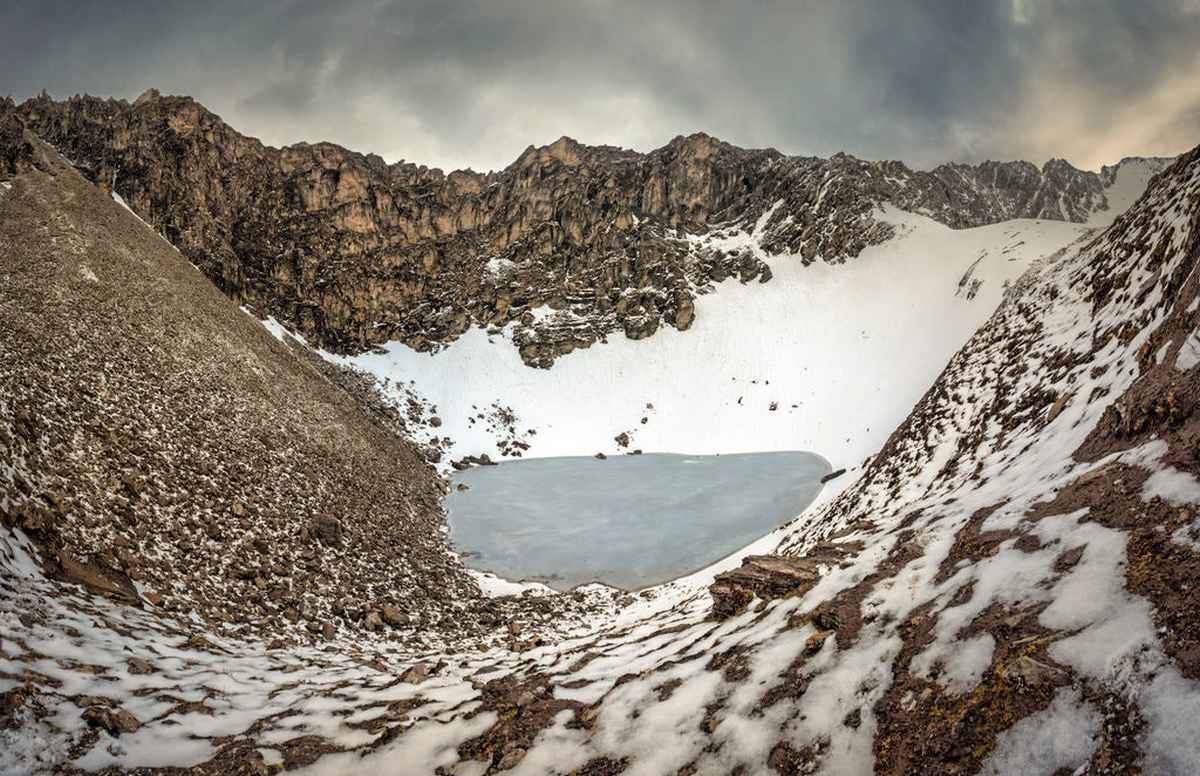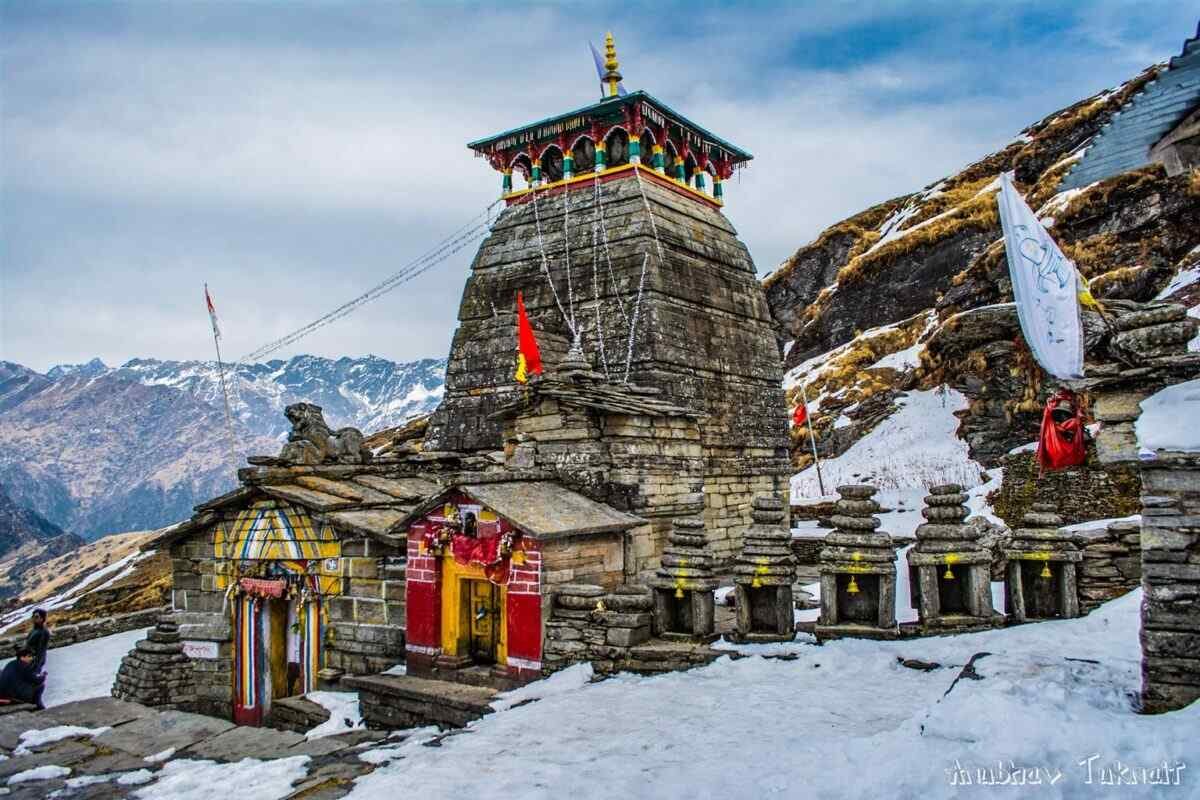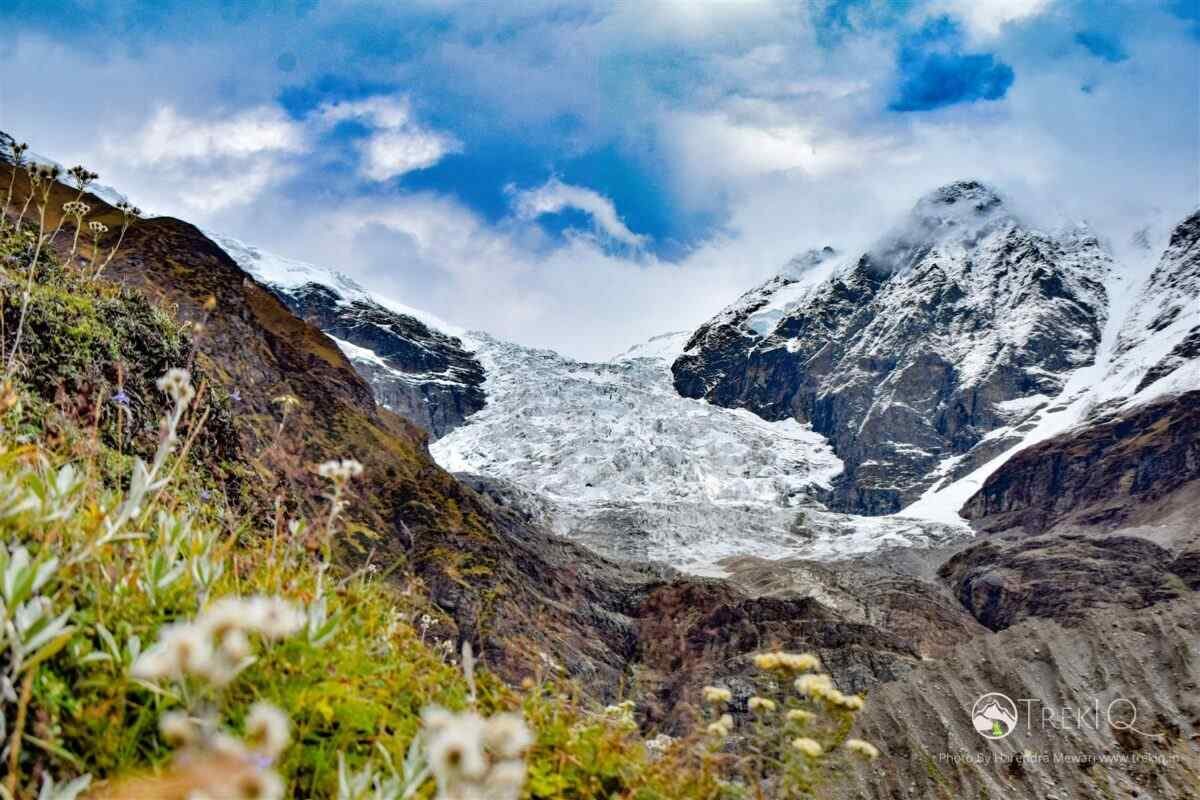₹14,500 / Person
Season: Autumn / Summer
Trek Length: 48 Km
Trip Duration: 8 Days
Trek Difficulty: Difficult
Experience: Experienced
Pickup & Drop: Kathgodam/Rishikesh
Roopkund Trek The Skeleton Lake Trek
Roopkund Lake is a mysterious lake hidden in the lap of Mighty Trishul Peak (7120m). Also known as the Skeleton Lake. There are hundreds of skeletons of different ages scattered in the Roopkund lake area. Due to this, it became worldwide famous. It grabs the attention of archaeologists, historians, photographers, adventure travelers, and many others. Roopkund lake trek is perhaps the most famous trek and one of the pioneer treks in India. Also, it is a dream trek for every genuine trekker.
Roopkund Lake has an elevation of 4796 m above sea level, and Base Camp Lohajung is 2334 m above sea level. Therefore, the altitude gain during trekking reaches more than 2462 m, which is a bit high. The last tree line found on this trek is at 3334m, which means till 1462m from there, you will not find any tree. Due to this reason, the oxygen level decreases while going toward the lake. Therefore acclimatization is compulsory before reaching Roopkund lake. Usually, for acclimatization, it requires 1-3 days. You should divide trekking distance into small steps and rest on alternative days. While hiking above 2500m, you should not climb more than 900 m in a single day.
Roopkund Lake is a part of the world-famous Nanda Devi Raj-Jat. Devotees organize ‘Nanda Devi Raj Jat’ every 12 years, starting from Nauti village near Karnprayag and passing through Roopkund lake. This 280 km-long journey takes three weeks to complete. It is probably one of the longest religious journeys in the world.
Mountain passes on the Roopkund trek
- Kalu Vinayak Pass(4325m / 14190ft).
- Junargali Pass(4820m / 15813ft).
Things You Must Keep In Mind Near Roopkund Lake
- Bathing, washing, spitting, and entering the lake are prohibited.
- Camping, cooking, and drinking lake water are also banned.
How to prepare for Roopkund Lake Trek
While attempting any Himalayan treks, you should have some preparations, according to the trek difficulties, at least one month prior. You should follow these exercises regularly:
Breathing Exercises
Slowly inhale as long as you can, then hold for a few seconds, then slowly exhale, then again hold your breath for a few seconds(3-4 sec). Repeat this whole process up to 8-10 times a day. Try to increase breath holding time and breathe only one time per 60 sec or more.
Jogging
You have to do 10 to 20 push-ups in a set of 3 every day for at least one month. It will strengthen your shoulders which helps you to carry your luggage easily. Also, it improves the strength of the lungs.
Staircase ascent/descent
Likewise, you can perform staircase ascent/descent exercises coupled with a weighted backpack. It is the most effective exercise. It will improve knee muscle strength. Therefore, it will help you to ascend uphill as well as to descend downhill.
Why Should you Follow These Exercises?
These exercises will improve your overall performance, which may help to make this trek easier. And most importantly, it will help you get acclimatized to high altitudes and reduce the chance of Acute Mountain Sickness or other severe forms of mountain sickness.
Best time for Roopkund trek
May, June, Mid-Aug to Oct
Roopkund trek starting point
Lohajung, Distt. Chamoli, Uttarakhand, PIN code-246427.
- Kathgodam/Rishikesh
- Lohajung
- Wan
- Ghairoli Patal
- Bedini Bugyal
- Patthar Nauchni
- Bhaguwabasa
- Roopkund
- Patthar Nauchni
- Ghairoli Patal
- Wan
- Lohajung
Itinerary for the Roopkund Trek
Day 1: Kathgodam/Rishikesh to Lohajung
- Distance - 220 Km
- Driving Time - 8 Hrs.
- Maximum Altitude - 2334m
Today you have to reach Lohajung Base Camp. If you are coming through Rishikesh, then you can come to Karnprayag via taxi or bus. Then you can reach Lohajung by taxi from Karnprayag. If you use public transport, then it will be much cheaper for you. If you are a group ( 6-7 people), you can book a taxi directly from Haldwani to Lohajung. It will save you a lot of time as well. Usually, taxi booking takes 6000-6500 INR.
Day 2: Lohajung To Ghairoli Patal Via Wan
- Distance - 15 km Drive + 8 Km Trekking
- Driving Time - 1 Hrs.
- Trekking Time - 5 Hrs.
- Altitude Gain - 834m
The first thing in the morning we will do is yoga, breathing exercises, and stretching. Then after breakfast, we will drive up to the Wan village, and then we will start trekking as soon as possible. After crossing the Wan village, we will cross the Neelganga River, located about 3 km from the Wan. After that, we will do a gradual climb of 5 km up to the Gharoli Patal. The elevation of Gharoli Patal is 3218 m, which is approximately 834 m above the Lohajung.
Day 3: Ghairoli Patal To Patthar Nauchni
- Distance - 8 Km
- Trekking Time - 5 Hrs.
- Altitude Gain - 582m
Wake up early in the morning and enjoy a beautiful morning. Then after exercising and stretching, we will have breakfast. Today, we will start trekking leisurely, as we have to get attuned to altitude change. Bedini Bugyal is only 3 km away from Ghairoli Patal. Here you will visit the ancient Nanda Devi temple and the Bedini Kund. The view of the gigantic Trishul from Bedini Bugyal (meadows) will surely mesmerize you.
In Bedini Bugyal, camping is ban. Due to this, the Roopkund trek becomes a bit difficult. We will set up a camp at Patthar Nauchni campsite if we get permission.
Day 4: Patthar Nauchni To Bhguwabasa
- Distance - 4 Km
- Trekking Time - 2 Hrs.
- Altitude Gain - 404m
If we have set up camp in Patthar Nauchni a day before, today we will only go to Bhaguvabasa via Kalu Vinayak pass (4325m). Else, we will rest at Bhaguwabasa today to get acclimatized. From Bhaguwabasa, the splendid views of Mount Trishul and Nandaghunti will make you mesmerize. There is nothing in between these mountains and you.
Day 5: Bhaguwabasa To Roopkund & Junargali and Return To Bhaguwabasa
- Distance - 8 Km
- Trekking Time - 6 Hrs.
- Altitude Gain - 560m
Hopefully, you guys have regained your energy, and you must have become accustomed to this altitude. Now is the time to hike Roopkund Lake. You have to be careful on the trek. The trek from Bhaguwabasa to Roopkund lake is a bit difficult. When you cross this steep path, you will have a sight of the mysterious Roopkund lake. After that, we will proceed towards Junargali Pass, which is on a 2 km climb from Roopkund Lake.
The altitude of Junargali is 4880m which is the highest point of the trek. You will see Ronti Saddle Pass, Sila Samudram, Homkund, Nanda Ghunti, Hathi-Ghori Parvat, Chaukhamba, and other peaks from here. From here, Mount Trishul will look as if you are standing at its root and looking at it. After spending some time in Junargali, we will return to Bhaguwabasa.
Day 6: Bhaguwabasa To Ghairoli Patal
- Distance - 12 Km
- Trekking Time - 6 Hrs.
- Altitude Lose - 986m
After having breakfast in the morning, we will start trekking from Bhaguwabasa towards Gharoli Patal. As soon as we cross Kalu Vinayak, we will not see the area of Roopkund and Junargali. The trekking path will be descending, so it will be easy for you to trek up to Ghairoli Patal.
Day 7: Ghairoli Patal To Lohajung Via Wan
- Distance - 8 km Trekking + 15 Km Drive
- Trekking Time - 4 Hrs.
- Driving Time - 1 Hrs.
- Altitude Lose - 834m
Today we will first descend to the Neelganga river, which is 4-5 km from the Ghairoli Patal campsite. The path passes through dense forests. You can hear the sweet sounds of birds. After ascending 1.5 km and descending another 1.5 km, Wan Market will come. Then we will go to the Lohajung via taxi. After having lunch, we will rest at Lohajung.
Day 8: Lohajung To Kathgodam
- Distance - 220 Km
- Driving Time - 8 Hrs.
Eventually, beautiful trekking came to its end with success. But from here, you will take beautiful and never forgettable memories of the Roopkund Lake trek with you. It will take about 8-9 hours to travel from Lohajung to Kathgodam. From there you will be able to go to your places by train, bus, and airplane.
Roopkund Trek price
₹14,500 Inc GST – Kathgodam to Kathgodam
Inclusion
- Transportation
- Accommodation Hotel/ Guesthouse/ Tents
- Nutritious meals as per itinerary.
- Safety Equipment (oxygen cylinder, first ad...)
- Tour Guide and support staff.
- Trekking Gears like Crampons, Gaiters (When needed).
- Forest entry charges, camping fee, and other charges.
- Necessary Permit
Exclusion
- Porter/Mule charges for carrying personal luggage.
- Any costs arising out of unforeseen circumstances like landslides, roadblocks, bad. Weather, etc.
- Trekking Gears like poles, shoes, poncho etc.
- Travel Insurance.
- Waterproof Trekking Shoes
- Woolen/Cotton Socks (Thick) - 3-4 Pairs
- Woolen sweater ( warm & Light )
- Jacket/Windcheater (waterproof 0° to -10° )
- Trek Pants/Lower - 2 units
- Thermal wears - 2 pairs
- Full Cotton T-shirts - 2-3 units
- Inner wears - 2-3 Pairs
- Gloves
- Sun cap
- Woolen cap
- Warm woolen shawl ( Thin & Light )
- Water Proof Rucksack ( 30-60 liter )
- Rain coat/Poncho
- Rain cover for your bag
- Portable Tourch/Headlamp
- Sunglasses
- Water Bottle
- Toiletries
- Winter Moisturizer Cream
- Lip Balm
- Sunscreen Lotion
- First Ad Kit ( ORS, AMS tablets, Band Ad, Pain Relief Spray, Coldarin, etc.)
Roopkund trek FAQs
Roopkund Lake is widely known for its hundreds of ancient human skeletons found on the shores of the lake. The human skeletal remains are visible at the bottom of Roopkund Lake when the snow melts. Research generally points to a semi-legendary event where people from different regions lost their lives by a violent hailstorm in the 9th century. Because of the human remains, the lake has been called Skeleton Lake in recent times. Around 300 – 600 skeletons are lying in the area. How did so many people lose their lives? A sudden hailstorm in the mountains might be the reason.
People found many skeletons of people from different periods, provinces, and countries near Roopkund lake. Apart from these, people also found some weapons, which point towards any war. All these things deepen the mystery of Roopkund Lake. That’s why Roopkund Lake is called a mysterious lake.
According to legends: Goddess Parvati had killed the demon Mahisasur near the Bedini Kund in her Kali avatar. Meanwhile, as Goddess Parvati and Lord Shiva were on their way to Kailash, Goddess Parvati felt unclean after killing the demons and wanted to have a bath. After all, she had cleaned up the dirt on the earth! To please her consort, Lord Shiva created a lake for the Goddess. The Goddess dipped herself in the blue waters of the lake and could see her beautiful reflection in the waters. It is why the lake is named Roopkund ( ‘Roop’ means beauty).
The elevation of Roopkund lake is about 4796m / 15735ft. It is one of the highest lakes in Uttarakhand.
The depth of Roopkund lake is about 3m.
Bhaguwabasa means: “abode of the tiger” Goddess Parvati had left her tiger at this point before heading towards Roopkund to take a bath.
The practice of sending Maa Nanda to her in-laws once in 12 years, is called Nanda Devi Raj Jat.
Shiva lived in his meditation. Nanda felt lonely in Kailash, where she remembered her maternal grandfather. Nanda called by her parent’s house. After a hiatus, he sent his beloved daughter to her in-laws’ house with great love and exultancy. Since then, every 12 years, the Nanda Devi Raj Jat is organized by the people in honor of Nanda Devi.
People from the Garhwal, Kumaon, other parts of India, and the world, participate in Nanda Devi Raj Jat yatra. The Goddess Nanda Devi is worshiped by the people from dozens of places in Kumaon and Garhwal. But the region around mount Nanda Devi and its sanctuary, which falls in the Pithoragarh district, Almora district, and Chamoli district, is the prime area related to Nanda Devi. In Chamoli, Nanda Devi Raj Jaat is organized once in 12 years. The Jaat ( Yatra or pilgrimage) starts from Nauti village near Karnprayag and goes up to the Roopkund and Homekund with a four-horned sheep. After the havan-yagna is over, the sheep let free with decorated ornaments, food, clothing, and the other offerings are discarded.
Pilgrims celebrate an annual Nanda Jaat yatra. The Raj Jaat procession goes through villages, where there is a recognized Nanda Devi temple. A night halt of the participants takes place at Koti, where night-long worship and celebrations take place.
Though in the Johar Valley region, there is no tradition of Nanda Raj Jaat. But the worship, dance, and the ritual of collecting Bramhakamal (it is called Kaul Kamphu) are part of Nanda festivals. The Nanda Devi fair is held at Almora, Nainital, Kot (Dangoli), Ranikhet, Bhowali, Kichha and also in the far flung villages of Lohar (like Milam and Martoli) and Pindar valleys (like Wachham and Khati).
In the villages of the Pinder valley, people celebrate the Nanda Devi Jaat (journey) every year. In the Lohar region, people come from the far end to Danadhar, Suring, Milam, and Martoli to worship the Goddess. In Nainital and Almora, thousands take part in the procession carrying the Dola of Nanda Devi. Some say that the Nanda Devi fairs started in Kumaon during the reign of King Kalyan Chand in the 16th century. There is a three-day fair at Kot Ki Mai or Kot Bhramari Devi. The fair at Saneti comes every second year. Both these fairs are rich in folk expressions, and many villages sell their products.
The source of the Neelganga river is nearby Bedini Kund.
Acclimatization is the process in which an individual organism adjusts to a change in its environment, allowing it to maintain performance across a range of environmental conditions. Acclimatization occurs in a short period and within the organism’s lifetime.
We can observe acclimatization when traveling to high altitude locations, such as tall mountains. For instance, if an individual hikes to 3,000 meters above sea level and stays there for 1-3 days, they become acclimatized to 3,000 meters. If the same person hikes to 4000 meters in altitude, their body has to acclimatize once again. Some of the changes that take place during acclimatization to high altitudes involve:
- Increased production of Red blood cells.
- Increased pressure in pulmonary arteries – thereby forcing blood into sections of the lungs that are usually not used during normal breathing at lower altitudes.
- Increased depth of respiration.
- Increased depth (volume) of breath.
In some cases, individuals suffer from Acute Mountain Sickness when ascending to elevations of over 3,000 meters from sea level. However, it is a common and mild condition. If the body gets enough time, then it can be overcome. The reason why it happens is- reduced air pressure at high altitudes as well as lower oxygen levels. One of the more severe forms of mountain sickness is called High Altitude Cerebral Edema, where fluid builds up in the brain. It is a life-threatening situation and requires immediate medical attention.
Roopkund Lake facts
Latitude & Longitude
30.261723°N 79.731673°E
Roopkund lake height
4796m / 15735ft
Max Altitude
4880m / 16010ft
Total trek distance
48 Km
Trip Duration
8 Days 7 Nights
Difficulty Level
- Difficult
- 2
Group Size
4-15
Age Group
12-60
Pickup Point
Kathgodam/Rishikesh
Drop Point
Kathgodam/Rishikesh
Activities
Essential facts
Nearest Medical Facility
Tharali
Nearest Hospital
Garur
Nearest ATM
Tharali
Mobile Connectivity
Lohajung
Last Electricity
Lohajung
Nearest Bus Station
Lohajung
Nearest Railway Station
Kathgodam
Nearest Airport
Pantnagar
Roopkund Lake Trek
You must be logged in to post a review.
Similar Treks..
- Rated 0 out of 5
Chopta Tungnath Trek
- ₹5,000 / Person
- Book Now
- Rated 0 out of 5
Kedarkantha Trek
- ₹7,000 / Person
- Book Now
- Rated 5.00 out of 5
Pindari Glacier Trek
- ₹10,500 / Person
- Book Now













Roopkund Lake Trek Reviews
There are no reviews yet.